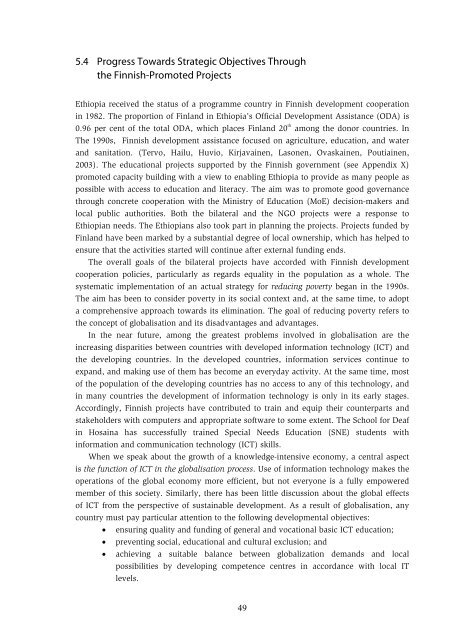Education and Training in Ethiopia An Evaluation of Approaching EFA Goals
Education and Training in Ethiopia - Koulutuksen tutkimuslaitos
Education and Training in Ethiopia - Koulutuksen tutkimuslaitos
- No tags were found...
You also want an ePaper? Increase the reach of your titles
YUMPU automatically turns print PDFs into web optimized ePapers that Google loves.
5.4 Progress Towards Strategic Objectives Throughthe F<strong>in</strong>nish-Promoted Projects<strong>Ethiopia</strong> received the status <strong>of</strong> a programme country <strong>in</strong> F<strong>in</strong>nish development cooperation<strong>in</strong> 1982. The proportion <strong>of</strong> F<strong>in</strong>l<strong>and</strong> <strong>in</strong> <strong>Ethiopia</strong>’s Official Development Assistance (ODA) is0.96 per cent <strong>of</strong> the total ODA, which places F<strong>in</strong>l<strong>and</strong> 20 th among the donor countries. InThe 1990s, F<strong>in</strong>nish development assistance focused on agriculture, education, <strong>and</strong> water<strong>and</strong> sanitation. (Tervo, Hailu, Huvio, Kirjava<strong>in</strong>en, Lasonen, Ovaska<strong>in</strong>en, Poutia<strong>in</strong>en,2003). The educational projects supported by the F<strong>in</strong>nish government (see Appendix X)promoted capacity build<strong>in</strong>g with a view to enabl<strong>in</strong>g <strong>Ethiopia</strong> to provide as many people aspossible with access to education <strong>and</strong> literacy. The aim was to promote good governancethrough concrete cooperation with the M<strong>in</strong>istry <strong>of</strong> <strong>Education</strong> (MoE) decision-makers <strong>and</strong>local public authorities. Both the bilateral <strong>and</strong> the NGO projects were a response to<strong>Ethiopia</strong>n needs. The <strong>Ethiopia</strong>ns also took part <strong>in</strong> plann<strong>in</strong>g the projects. Projects funded byF<strong>in</strong>l<strong>and</strong> have been marked by a substantial degree <strong>of</strong> local ownership, which has helped toensure that the activities started will cont<strong>in</strong>ue after external fund<strong>in</strong>g ends.The overall goals <strong>of</strong> the bilateral projects have accorded with F<strong>in</strong>nish developmentcooperation policies, particularly as regards equality <strong>in</strong> the population as a whole. Thesystematic implementation <strong>of</strong> an actual strategy for reduc<strong>in</strong>g poverty began <strong>in</strong> the 1990s.The aim has been to consider poverty <strong>in</strong> its social context <strong>and</strong>, at the same time, to adopta comprehensive approach towards its elim<strong>in</strong>ation. The goal <strong>of</strong> reduc<strong>in</strong>g poverty refers tothe concept <strong>of</strong> globalisation <strong>and</strong> its disadvantages <strong>and</strong> advantages.In the near future, among the greatest problems <strong>in</strong>volved <strong>in</strong> globalisation are the<strong>in</strong>creas<strong>in</strong>g disparities between countries with developed <strong>in</strong>formation technology (ICT) <strong>and</strong>the develop<strong>in</strong>g countries. In the developed countries, <strong>in</strong>formation services cont<strong>in</strong>ue toexp<strong>and</strong>, <strong>and</strong> mak<strong>in</strong>g use <strong>of</strong> them has become an everyday activity. At the same time, most<strong>of</strong> the population <strong>of</strong> the develop<strong>in</strong>g countries has no access to any <strong>of</strong> this technology, <strong>and</strong><strong>in</strong> many countries the development <strong>of</strong> <strong>in</strong>formation technology is only <strong>in</strong> its early stages.Accord<strong>in</strong>gly, F<strong>in</strong>nish projects have contributed to tra<strong>in</strong> <strong>and</strong> equip their counterparts <strong>and</strong>stakeholders with computers <strong>and</strong> appropriate s<strong>of</strong>tware to some extent. The School for Deaf<strong>in</strong> Hosa<strong>in</strong>a has successfully tra<strong>in</strong>ed Special Needs <strong>Education</strong> (SNE) students with<strong>in</strong>formation <strong>and</strong> communication technology (ICT) skills.When we speak about the growth <strong>of</strong> a knowledge-<strong>in</strong>tensive economy, a central aspectis the function <strong>of</strong> ICT <strong>in</strong> the globalisation process. Use <strong>of</strong> <strong>in</strong>formation technology makes theoperations <strong>of</strong> the global economy more efficient, but not everyone is a fully empoweredmember <strong>of</strong> this society. Similarly, there has been little discussion about the global effects<strong>of</strong> ICT from the perspective <strong>of</strong> susta<strong>in</strong>able development. As a result <strong>of</strong> globalisation, anycountry must pay particular attention to the follow<strong>in</strong>g developmental objectives:• ensur<strong>in</strong>g quality <strong>and</strong> fund<strong>in</strong>g <strong>of</strong> general <strong>and</strong> vocational basic ICT education;• prevent<strong>in</strong>g social, educational <strong>and</strong> cultural exclusion; <strong>and</strong>• achiev<strong>in</strong>g a suitable balance between globalization dem<strong>and</strong>s <strong>and</strong> localpossibilities by develop<strong>in</strong>g competence centres <strong>in</strong> accordance with local ITlevels.49




![to read the full report [pdf, Amharic] - Ethiopian Review](https://img.yumpu.com/52737829/1/190x245/to-read-the-full-report-pdf-amharic-ethiopian-review.jpg?quality=85)











